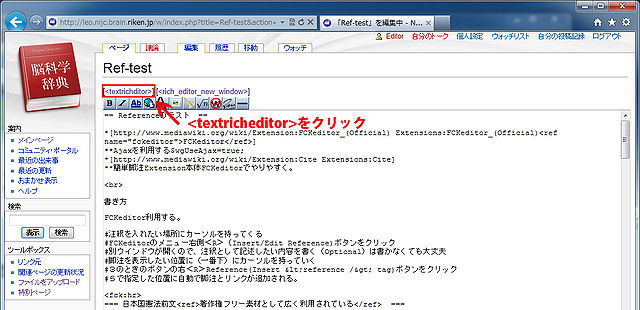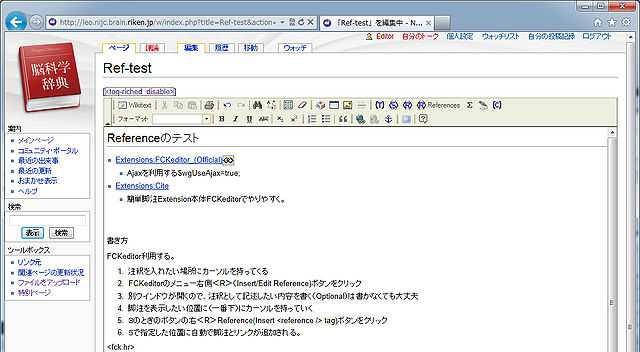ヘルプ:テキストの書き方
- 基本的なWikiの構文の文法に関しては、下記をご参照下さい.
Text Rich Editor
- また本サイトではWiki構文を使わずに、ワードプロセッサーソフトウエア様の入力を可能にするText Rich Editorも実装しています.
- Wikiページの編集画面を表示して<textricheditor>をクリックします。
- 入力画面が変化します。
- 記事の見出しはHeading 2から始め、3、4と小さくしていって下さい。
文献の入れ方
- Text Rich Editorはここでは使用しないで下さい。
- 下の様に文献を引用したい場所で<ref><pubmed> と</pubmed></ref>の間にPubMed IDを囲って下さい。
*****<ref><pubmed> 14426011 </pubmed></ref>。
すると、文章内の記述順に従って、右のように引用文献が番号で表されます。 *****[1] 。
- おなじ文献を2回以上使いたい時は、一番最初に引用した時に名前をつけます。二回目以降は名前だけで充分です。
始めの引用<ref name=ref2><pubmed> 1432144 </pubmed></ref>。
始めの引用[2]。
2回目の引用<ref name=ref2 />。
2回目の引用[2]。
- Pubmedにない文献(日本語の文献や単行本など)は次の様に書いて下さい。
日本語の文献の引用例です<ref>'''藤田尚男、藤田恒夫'''<br>標準組織学 総論 第4版<br>''医学書院(東京)'':2002</ref>。
日本語の文献の引用例です[3]。
- そして記述の最後に次の様に入力します.
<references/>
すると、文献リストが出来ます.
- ↑
NARAHASHI, T., DEGUCHI, T., URAKAWA, N., & OHKUBO, Y. (1960).
Stabilization and rectification of muscle fiber membrane by tetrodotoxin. The American journal of physiology, 198, 934-8. [PubMed:14426011] [WorldCat] [DOI] - ↑ 2.0 2.1
Faria, M.A. (1992).
The death of Henry II of France. Journal of neurosurgery, 77(6), 964-9. [PubMed:1432144] [WorldCat] [DOI] - ↑ 藤田尚男、藤田恒夫
標準組織学 総論 第4版
医学書院(東京):2002
数式の入力
- Textricheditorでは数式入力はできません.デフォールトの入力方法を用い、MediaWikiの数式記述法を参照して、入力してください.以下に例を示します.
<math>\int f(x)dx</math>
<math>\alpha \frac{d^2x(t)}{dt^2} +\beta \frac{dx(t)}{dt} +\gamma x(t) = f(t)</math>
<math>\int f(xyz)dx</math>
特殊文字一覧
これらを入力する時は、TextRichEditorは使えません。デフォールトの入力方法で御使い下さい。
- Numbers: ¼ ½ ¾ ¼ ½ ¾
- Fractions:½ ⅓ 7⁄9 {{Fraction|1|2}} {{Fraction|1|3}} {{Fraction|7|9}}
- Font size: x x <big>x</big> <small>x</small>
- Underline text underline overline <u> underline </u> {{overline|overline}}
- Strikeout text
strikeout<s> strikeout </s> - Font: italics bold — ''italics'' '''bold'''
- General font specification: Φ (A) <span style="font-family: Times New Roman; font-size:100%; font-style:italic; font-weight:bold;"> Φ (A) </span>;
- Superscripts/subscripts: x2 x3 x2
1 x<sup>2</sup> x<sub>3</sub> x{{su|p=2|b=1}}; - Analysis: ƒ ∂ ∫ ∑ ∏ √ ∞ ∇ ℘ ℑ ℜ ƒ ∂ ∫ ∑ ∏ √ ∞ ∇ ℘ ℑ ℜ
- Arrows: ← ↓ → ↑ ↔ ↵ ⇐ ⇓ ⇒ ⇑ ⇔ ← ↓ → ↑ ↔ ↵ ⇐ ⇓ ⇒ ⇑ ⇔
- Logic: ¬ ∧ ∨ ∃ ∀ ¬ ∧ ∨ ∃ ∀
- Sets: ∈ ∉ ∋ ∅ ⊆ ⊇ ⊃ ⊂ ⊄ ∪ ∩ ℵ ∈ ∉ ∋ ∅ ⊆ ⊇ ⊃ ⊂ ⊄ ∪ ∩ ℵ
- Relations: ≠ ≤ ≥ < > ≡ ≢ ∼ ≅ ≈ ∝ ≠ ≤ ≥ < > ≡ ≢ ∼ ≅ ≈ ∝
- Binary operations: ± − × ÷ ⁄ ⊥ ⊕ ⊗ ∗ ± − × ÷ ⁄ ⊥ ⊕ ⊗ ∗
- Delimiters: ⌈ ⌉ ⌊ ⌋ ⟨ ⟩ « » ⌈ ⌉ ⌊⌋ ⟨ ⟩ « »
- Miscellaneous: † ‡ ¦ ∠ ∴ ◊ • ♠ ♣ ♥ ♦ † ‡ ¦ ∠ ∴ ◊ • ♠ ♣ ♥ ♦
- Punctuation: ′ ″ ‾ ° ⋅ · … – — ˆ ′ ″ ‾ ° ⋅ · … – — ˆ
- Spacing: thin ( ), n-width ( ), m-width ( ), and non-breaking spaces ( ).      
- Greek: α β γ Α Β Γ etc. α β γ Α Β Γ etc.
- Unicode: ⊢ (for example) gives the character ⊢ with unicode number x22A2 (hexadecimal). Warning: many of the more obscure unicode characters do not yet work on all browsers. Additionally, this makes it very hard to read the wikitext.




